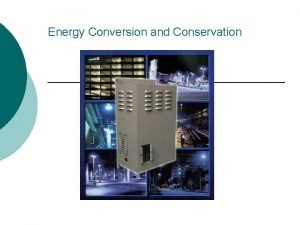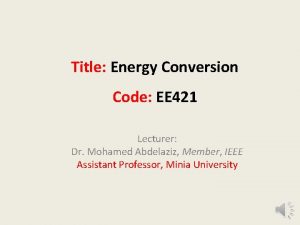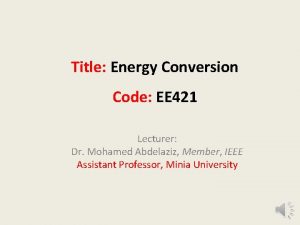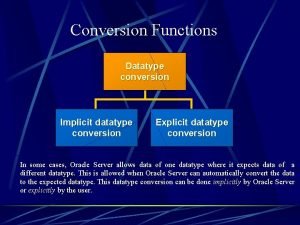Title Energy Conversion Code EE 421 Lecturer Dr













- Slides: 13

Title: Energy Conversion Code: EE 421 Lecturer: Dr. Mohamed Abdelaziz, Member, IEEE Assistant Professor, Minia University

Chapter 1: Principles of Renewable Energy John Twidell and Tony Weir “Renewable Energy Resources”, Third Edition, 2015.

1. 3 Fundamentals 1. 3. 1 Definitions -For all practical purposes energy supplies can be divided into two classes: -Renewable energy. Energy obtained from natural and the flows of energy occurring in the immediate environment. -An obvious example is solar (sunshine) energy. -Note that the energy is passing through the environment as a current or flow, irrespective of there being a device to intercept and harness this power. Such energy may also be called Green Energy or Sustainable Energy.

-Non-renewable energy. Energy obtained from static stores of energy that remain underground unless released by human interaction. -Examples are nuclear fuels and fossil fuels of coal, oil and natural gas. -Note that the energy is initially an isolated energy potential, and external action is required to initiate the supply of energy for practical purposes. -To avoid using the ungainly word ‘non-renewable’, such energy supplies are called finite supplies or Brown Energy.

A comparison of renewable and conventional energy systems.

1. 3. 2 Energy sources There are five primary sources of useful energy: 1. The Sun. 2. The motion and gravitational potential of the Sun, Moon and Earth. 3. Geothermal energy. 4. Human-induced nuclear reactions. 5. Chemical reactions from mineral sources.

-Renewable energy derives continuously from sources 1, 2 and 3. -Finite energy derives from sources 1 (fossil fuels), 3 (hot rocks), 4 and 5. -The sources of most significance for global energy supplies are 1 and 4. -The fifth category is relatively minor, but useful for primary batteries, e. g. dry cells.

1. 3. 3 Environmental energy -The flows of energy passing continuously as renewable energy through the Earth are shown in this Figure.

• The solar flux reaching the Earth’s surface is ~20 MW person; 20 MW is the power of ten very large diesel electric generators, enough to supply all the energy needs of a town of about 50, 000 people!

1. 3. 4 Primary supply to end-use -All energy systems can be visualized as a series of pipes or circuits through which the energy currents are channeled and transformed to become useful in domestic, industrial and agricultural circumstances. -Figure 1. 3(a) is a Sankey diagram of energy supply, which shows the energy flows through a national energy system (sometimes called a ‘spaghetti diagram’ because of its appearance).

Figure 1. 3 Energy flow diagrams for Austria in 2000, with a population of 8. 1 million. (a) Sankey (‘spaghetti’) diagram

-Sections across such a diagram can be drawn as pie charts showing primary energy supply and energy supply to enduse. (b) pie diagram of sources; (c) pie diagram of end uses.

Best wishes, Dr. Mohamed A. Mohamed
 Lecturer's name or lecturer name
Lecturer's name or lecturer name Energy conversion means saving energy
Energy conversion means saving energy Physician associate lecturer
Physician associate lecturer Spe distinguished lecturer
Spe distinguished lecturer Good afternoon class
Good afternoon class Photography lecturer
Photography lecturer Lecturer in charge
Lecturer in charge Designation lecturer
Designation lecturer Designation of lecturer
Designation of lecturer Why himalayan rivers are pernnial in nature
Why himalayan rivers are pernnial in nature Lecturer name
Lecturer name Pearson lecturer resources
Pearson lecturer resources 140000/120
140000/120 Lector vs lecturer
Lector vs lecturer

























